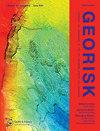Slope Failure and Landslide Detection in Huangdao District of Qingdao City Based on an Improved Faster R-CNN Model
IF 4.8
3区 工程技术
Q1 ENGINEERING, GEOLOGICAL
Georisk-Assessment and Management of Risk for Engineered Systems and Geohazards
Pub Date : 2023-08-01
DOI:10.3390/geohazards4030017
引用次数: 0
Abstract
To reduce the significant losses caused by slope failures and landslides, it is of great significance to detect and predict these disasters scientifically. This study focused on Huangdao District of Qingdao City in Shandong Province, using the improved Faster R-CNN network to detect slope failures and landslides. This study introduced a multi-scale feature enhancement module into the Faster R-CNN model. The module enhances the network’s perception of different scales of slope failures and landslides by deeply fusing high-resolution weak semantic features with low-resolution strong semantic features. Our experiments show that the improved Faster R-CNN model outperformed the traditional version, and that ResNet50 performed better than VGG16 with an AP value of 90.68%, F1 value of 0.94, recall value of 90.68%, and precision value of 98.17%. While the targets predicted by VGG16 were more dispersed and the false detection rate was higher than that of ResNet50, VGG16 was shown to have an advantage in predicting small-scale slope failures and landslides. The trained Faster R-CNN network model detected geological hazards of slope failure and landslide in Huangdao District, missing only two landslides, thereby demonstrating high detection accuracy. This method can provide an effective technical means for slope failures and landslides target detection and has practical implications.基于改进更快R-CNN模型的青岛市黄岛区边坡破坏与滑坡检测
为了减少边坡破坏和滑坡造成的重大损失,科学地检测和预测这些灾害具有重要意义。本研究以山东省青岛市黄岛区为研究对象,采用改进的Faster R-CNN网络对边坡破坏和滑坡进行检测。本研究在Faster R-CNN模型中引入了多尺度特征增强模块。该模块通过深度融合高分辨率弱语义特征和低分辨率强语义特征,增强网络对不同尺度边坡破坏和滑坡的感知能力。我们的实验表明,改进的Faster R-CNN模型优于传统版本,并且ResNet50的AP值为90.68%,F1值为0.94,召回值为90.68%,精度值为98.17%,优于VGG16。与ResNet50相比,VGG16预测的目标更分散,误检率更高,但VGG16在预测小规模边坡破坏和滑坡方面具有优势。训练后的Faster R-CNN网络模型对黄岛地区的边坡破坏和滑坡地质灾害进行了检测,仅遗漏了2个滑坡,检测精度较高。该方法可为边坡破坏和滑坡目标检测提供有效的技术手段,具有实际应用价值。
本文章由计算机程序翻译,如有差异,请以英文原文为准。
求助全文
约1分钟内获得全文
求助全文
来源期刊
CiteScore
8.70
自引率
10.40%
发文量
31
期刊介绍:
Georisk covers many diversified but interlinked areas of active research and practice, such as geohazards (earthquakes, landslides, avalanches, rockfalls, tsunamis, etc.), safety of engineered systems (dams, buildings, offshore structures, lifelines, etc.), environmental risk, seismic risk, reliability-based design and code calibration, geostatistics, decision analyses, structural reliability, maintenance and life cycle performance, risk and vulnerability, hazard mapping, loss assessment (economic, social, environmental, etc.), GIS databases, remote sensing, and many other related disciplines. The underlying theme is that uncertainties associated with geomaterials (soils, rocks), geologic processes, and possible subsequent treatments, are usually large and complex and these uncertainties play an indispensable role in the risk assessment and management of engineered and natural systems. Significant theoretical and practical challenges remain on quantifying these uncertainties and developing defensible risk management methodologies that are acceptable to decision makers and stakeholders. Many opportunities to leverage on the rapid advancement in Bayesian analysis, machine learning, artificial intelligence, and other data-driven methods also exist, which can greatly enhance our decision-making abilities. The basic goal of this international peer-reviewed journal is to provide a multi-disciplinary scientific forum for cross fertilization of ideas between interested parties working on various aspects of georisk to advance the state-of-the-art and the state-of-the-practice.

 求助内容:
求助内容: 应助结果提醒方式:
应助结果提醒方式:


